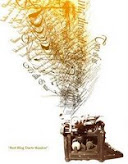Beginning with the Impressionists at the end of the 1800s, art began to shift from realistic images to abstract images. In other words, artists became less concerned with painting a landscape and more concerned with the emotions a painting could stir in the viewer.
An excellent example of this development is Claude Monet’s Water Lilies series. In his first paintings of water lilies, Monet takes care to create realistic, recognizable lilies floating on a pond. By the end of his life, the lilies are hardly more than green smudges on a blue background, but the effect of the paintings (in my opinion) remains powerful. The first image is an early painting and the second is a late example of Monet's Water Lilies
An excellent example of this development is Claude Monet’s Water Lilies series. In his first paintings of water lilies, Monet takes care to create realistic, recognizable lilies floating on a pond. By the end of his life, the lilies are hardly more than green smudges on a blue background, but the effect of the paintings (in my opinion) remains powerful. The first image is an early painting and the second is a late example of Monet's Water Lilies

 I would not claim that Monet was an abstract artist. This is just meant to illustrate the process of moving from art that shows recognizable subjects to art that does not.
I would not claim that Monet was an abstract artist. This is just meant to illustrate the process of moving from art that shows recognizable subjects to art that does not.An abstract artist whom you’ve read about already was Jackson Pollock. There are no fruit bowls in his splatter paintings. No stiffly posed women or shimmering ponds. He meant to do something more than record scenes. He meant to record emotion. Pollock looked inward at the chaos in his mind and laid it out on massive canvases so that we could feel what he felt.
In the next few days I’ll post about some other abstract artists. For now though, look back on my posts about Piet Mondrian and Pablo Picasso.
Please note that the term “abstract art” is very general. Cubism is a form of abstract art, as is neoplasticism (the movement Mondrian painted in), and many others.
Return to main page.







No comments:
Post a Comment